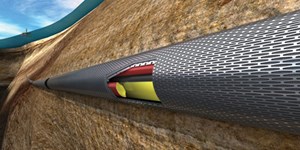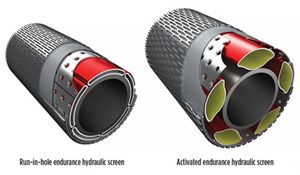Compliant screen raises the bar for successful and cost-efficient sand control
With 70% of mature and deepwater wells requiring some form of downhole sand control, it is essential for operators to use an effective method. Endurance Hydraulic Screen (EHS) technology—a next-generation, Halliburton sand control solution—offers an alternative to the traditional sand control methods of gravel packing and mechanically expanded screens (Fig. 1), providing installation simplicity, operational flexibility and life-of-well reliability.
Compliant screens predominantly remove the annular gap between the screen and open hole, and assist in providing borehole stability to prevent fines migration and potential plugging. Sand production is an ongoing, escalating challenge, affecting productivity and causing damage to a well’s equipment.
The EHS system delivers a new level of sand control completion. It provides reservoir compliance through positive wellbore support, along with increased operational efficiency, reservoir management and inflow control. “The EHS system eliminates the need for downhole expansion tools and the potential requirement for gravel packing,” said Maxime Coffin, sand control product manager for Halliburton. “Additionally, this pump-free system can be deployed and activated in just one simple run, thus minimizing risk and cost. Traditional sand control methods can be more complex, require more rig time and usually less cost effective.”
Several years ago, EHS technology was tested and qualified for an operator in the Gulf of Mexico, in temperatures up to 375°F and reservoir pressures reaching 18,000 psi. Then, in 2015, an operator in Norway required a sand control solution for mature wells offshore, where depletion challenges and the field’s narrowing pore/frac pressure window made pumping gravel packs a challenge. To solve these issues, the operator wanted a pump-free solution, and EHS technology was deployed to prove its capabilities.
During this deployment, the screen was run with standard completion equipment in an 8.5-in. open hole, which was drilled to a depth of 8,465 ft, with a maximum deviation of 30° and a temperature of approximately 176°F. The completion took six days, compared to a field average of nine days with open-hole gravel packing, reducing overall completion time more than 30%. The EHS system also reduced HSE risks. Since the system’s installation uses standard rig equipment, risks to personnel were low.
This pump-free system achieves open-hole-compliant sand control through surface-applied pressure. This takes no more than one hour of rig time (compared to several days for traditional sand control). Activated by applied pressure from the surface, a maximum crew of two is required for the installation (vs. gravel-pack operations, which require up to 10 people). Further simplifying the sand control process, the EHS solution’s solid basepipe version removes the need to run washpipe. Complementing zonal isolation and multi-zone completions, EHS technology is compatible with standard equipment and can be deployed through multi-laterals for enhanced reservoir contact.
Achieving flow performance and reliable sand control, in open-hole sand completions, can require the removal of the annular gap. EHS technology is designed to provide strong wellbore support, and is well suited to overcome the challenges associated with open-hole gravel packing in depleted reservoirs, with low operational margins.
“As operators drill in deeper and more remote offshore locations, they are looking at more efficient ways to complete their wells, in order to lower their cost per barrel of oil equivalent,” Coffin said. “Another major driver for the development of more advanced sand-control completion systems has been the need to complete multiple zones or reservoirs in a single trip. The EHS system can accomplish sand control in various intervals in just one trip, so it clearly meets operators’ needs.”
In designing EHS technology, the service company eliminated the need for gravel packing entirely. The 8.5-in. openhole EHS system was released in 2015, followed by a 6-in. open-hole version in 2017.
The EHS solid basepipe version comprises a screen inflow area and valve module. Each joint provides a fully integrated hydraulic screen that extends radially to support the wellbore with the application of surface-applied pressure. When the screen reaches the desired depth, internal tubing pressure is applied from the surface, via the rig’s cementing unit. This pressurizes the screen’s activation chambers, causing the screen diameter to increase and close the annular gap, Fig. 2. The system is activated by surface-applied pressure, without traditional fluid circulation techniques, saving time and money.
With a screen section similar in construction to metal mesh products, hydraulic screens are deployed with the same logistics, rig handling operations and pipe makeup equipment as with stand-alone screen (SAS) applications. Deployed in either water- or oil-based muds, fluid considerations follow the same industry-recognized protocols for achieving acceptable levels of cleanliness, by production screen testing (PST), before running in hole.
Hydraulic activation of the screen is achieved with surface pressure applied from the rig’s cementing unit to the inside of the entire lower completion, via the drill pipe. Pressure acts on all screen joints, simultaneously, to perform activation in just one step, to set the screens against the wellbore, closing the annular gap. The valve module, integrated to the pin end of each screen, provides deployment functionality, conveys pressure to perform screen activation and opens communication to the reservoir, once the screen is activated.
Screen activation occurs after initial surface-applied pressure moves the valve position, enabling communication to the activation chambers. As volume is added and pressure rises, these chambers plastically deform and extend radially, thus increasing the outer diameter to contact the wellbore. Final setting pressure is retained within each chamber. If pressure cannot be maintained, the plastically deformed chambers retain their set positions.
Once the screen is activated, the pressure is bled off and the screens are opened to production. Produced hydrocarbons flow through the system’s layer sequences—protective shroud, filter media and drainage layer. After it has passed through these layers, produced fluid enters flow channels between the activation chambers.
In its final position, the valve is open to the reservoir, allowing 360° of production flow to travel into the screen, along the length of the filter media. Flow finally enters the production tubing through ports in the valve mechanism. In this case, the flow regime is similar in nature to that of an inflow control device (ICD) screen.
For additional reservoir management and full inflow control capability, EHS technology is compatible with the Halliburton EquiFlow Autonomous Inflow Control Device (AICD) and SmartWell system. While the AICD performs the same function as a standard ICD during oil production, it also restricts unwanted liquid or gas production, at the time of breakthrough. This tool works to balance production through the interval, increase recoverable reserves and extend well production.
The EquiFlow AICD has no moving parts, electronics or connections to the surface. It does not require downhole orientation and utilizes dynamic fluid properties to direct fluid flow. Each EquiFlow device functions independently for precise response to the reservoir.
In horizontal wellbores, when changing reservoir conditions cause unwanted gas and/or water to migrate to the wellbore (or when uneven production distribution arises, due to a pressure drop in the tubing), operators rely on the simple, reliable and cost-effective EquiFlow AICD to:
- Delay the unwanted fluid flow of water and gas into the horizontal wellbore
- Increase reliability through design simplicity
- Minimize undesired fluid production
- Balance production through the interval
- Increase recoverable reserves and extend well production
- Reduce the cost and risk of handling unwanted fluid at surface.
When combined with the EquiFlow AICD and SmartWell system, this technology provides a compliant sand control solution that has proven its suitability in the world’s most challenging drilling environments. As operators strive to reduce costs, increase operational efficiencies and increase recoverable reserves, this simple yet powerful solution reduces completion time, costs and risks, when compared with traditional sand control methods.
The technology enables operators to meet the complex challenges of sand production, along with its effect on productivity and downhole equipment. It simplifies installation of sand control equipment and ensures reliable performance, throughout well life. To date, EHS technology has proven its capability to:
- Provide positive and effective, compliant sand control
- Deliver strong wellbore support, using a standard API basepipe platform
- Enable single-trip installations with record time-savings (no expansion trip, and no need for washpipe)
- Provide reservoir management and full inflow control capability with inflow control devices (ICDs)
- Complement zonal isolation and multi-zone completions.
“Recently, Halliburton extended its flawless EHS track record to 14 successful installations,” said Keith Oddie, principal product champion for compliant screens at Halliburton. “As a direct replacement for gravel packing, 13 of these installations have been completed offshore Norway, in 8.5-in. and 6-in. open-hole applications. The latest installation was performed, as per procedure, and without incident, with 13 joints of 4-in. EHS installed in a 6-in. open hole across a 656-ft interval—a record quantity of EHS screen joints installed in a single well to date.” After reaching TD at 16,404 ft, MD, the liner hanger setting and EHS activation were completed within one hour. The two-person EHS crew supervised operations at the wellsite.
Prior to running screens, the well was displaced to a low-solids, oil-based mud, with fluid cleanliness verified via PST for an EHS with a 230-micron filtration weave. Four-inch EHS joints were deployed below a liner hanger and run to TD. The client did not require circulation capability, thus a solid bullnose was installed below the screens. The bullnose and EHS solid basepipe system, in the “closed” position, provided sealing to activate the hydraulic screens and remove the need to drop a liner-hanger setting ball. An inner string was not required, since a reservoir isolation barrier was not deployed.
Screen activation was monitored, using the rig data acquisition equipment, with pressure and volume data being the primary method for confirming successful activation of all screens against the 6-in. open-hole wellbore. Additional indication of screen activation was achieved by monitoring open-hole fluid displacement to the trip tank. The unique EHS pressure activation signature and a post-activation circulation test were used to verify that the flow path, through the screen production ports, was open. Since introduction to this field, the EHS system has consistently delivered major operational efficiencies compared to gravel pack, contributing to an overall reduction in completion time of more than 30%.
Halliburton’s fourteenth EHS installation in West Africa was performed successfully. It marked the first installation for this operator, which needed a solution to its complex, labor-intensive gravel-pack operation, across a 6-in. open-hole reservoir, in a remote location.
With these positive results and global interest in EHS intensifying, this next-generation technology is firmly established as a viable alternative to traditional methods, and a primary solution for offshore fields. Since its launch in 2015, EHS technology has successfully performed complex sand-control operations, maximized asset values and achieved objectives of late-life, well development strategies. ![]()
LITERATURE CITED
1 K. Oddie, M. Clark, and J. Evans, Halliburton; E.S. Arnestad, T. Davidian, and M. Ravndal, Statoil. OTC-27016-MS, “A novel approach to replacing a gravel pack completion using hydraulic screens to remove the annular gap.”
- Coiled tubing drilling’s role in the energy transition (March 2024)
- Digital tool kit enhances real-time decision-making to improve drilling efficiency and performance (February 2024)
- E&P outside the U.S. maintains a disciplined pace (February 2024)
- Prices and governmental policies combine to stymie Canadian upstream growth (February 2024)
- U.S. operators reduce activity as crude prices plunge (February 2024)
- U.S. producing gas wells increase despite low prices (February 2024)
- Applying ultra-deep LWD resistivity technology successfully in a SAGD operation (May 2019)
- Adoption of wireless intelligent completions advances (May 2019)
- Majors double down as takeaway crunch eases (April 2019)
- What’s new in well logging and formation evaluation (April 2019)
- Qualification of a 20,000-psi subsea BOP: A collaborative approach (February 2019)
- ConocoPhillips’ Greg Leveille sees rapid trajectory of technical advancement continuing (February 2019)




